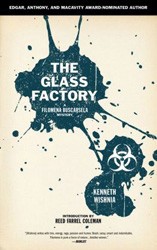By
– August 31, 2011
What does a voodoo princess, a New York City medical examiner who also happens to be a cantor, a grave robber, Holocaust historian Yehuda Bauer, former U.S. Holocaust Memorial Museum director Michael Berenbaum, and David Duke, among many other memorable characters have in common? They are all interviewed in journalist Mark Jacobson’s riveting account of his search to uncover the provenance and authenticity of a tattooed lampshade made of human skin. Reminiscent of Daniel Mendelsohn’s unforgettable quest to uncover the fate of six members of his family during the Holocaust in The Lost, Jacobson also takes us on a journey to validate a lampshade, given to him in the aftermath of Hurricane Katrina, which was ostensibly made in Buchenwald by concentration camp doctors from the skin of a prisoner in Buchenwald.
DNA testing having confirmed that the lampshade is indeed made of human skin, Jacobson is surprised to learn that neither Yad Vashem nor the United States Holocaust Museum is interested in receiving this artifact of horror. He is told that even if it could be proved that the lampshade is indeed the skin of a Buchenwald prisoner, it would constitute an aberration, the work of a small number of sadistic Nazi personnel, thus inconsequential to our knowledge of the Holocaust.
Yet when one thinks of the Holocaust, what comes to mind are the two most repellant symbols of Nazi terror, the lampshade made of human skin and soap made of Jewish “fat.” In his interview with Yehuda Bauer, the Holocaust historian dismisses the “Jews made into soap” story as without a factual basis, although Nazi businessmen did contemplate its manufacture, but there was little time or money at the end of the war to contemplate its production. The lampshade made from skin, however, is a different story. Jacobson has tracked much of its history starting with Ilse Koch, the so-called “Bitch of Buchenwald,” to its use as evidence at the Nuremberg Tribunal following the war. A fascinating journey which, at its end, leaves Jacobson with the dilemma of what to do with one of the primary symbols of Nazi horror, which at the same time is discounted as irrelevant by the custodians of Holocaust history.
DNA testing having confirmed that the lampshade is indeed made of human skin, Jacobson is surprised to learn that neither Yad Vashem nor the United States Holocaust Museum is interested in receiving this artifact of horror. He is told that even if it could be proved that the lampshade is indeed the skin of a Buchenwald prisoner, it would constitute an aberration, the work of a small number of sadistic Nazi personnel, thus inconsequential to our knowledge of the Holocaust.
Yet when one thinks of the Holocaust, what comes to mind are the two most repellant symbols of Nazi terror, the lampshade made of human skin and soap made of Jewish “fat.” In his interview with Yehuda Bauer, the Holocaust historian dismisses the “Jews made into soap” story as without a factual basis, although Nazi businessmen did contemplate its manufacture, but there was little time or money at the end of the war to contemplate its production. The lampshade made from skin, however, is a different story. Jacobson has tracked much of its history starting with Ilse Koch, the so-called “Bitch of Buchenwald,” to its use as evidence at the Nuremberg Tribunal following the war. A fascinating journey which, at its end, leaves Jacobson with the dilemma of what to do with one of the primary symbols of Nazi horror, which at the same time is discounted as irrelevant by the custodians of Holocaust history.
Abraham J. Edelheit is an associate professor of history at Kingsborough Community College (CUNY) and the author, co-author, or editor of eleven books on the Holocaust, Zionism, Jewish and European history, and Military affairs. His most recent publication appeared in Armor magazine, the official journal of the US Army Armor and Cavalry Command.




